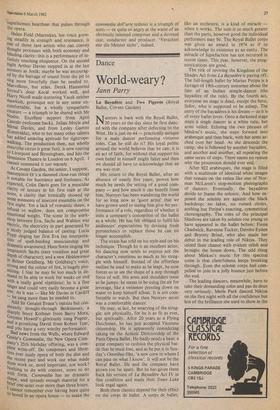Dance
World-weary?
Jann Parry
1\jureyev is back with the Royal Ballet, 1 20 years to the day since he first danc- ed with the company after defecting to the West. He is just on 44 — practically antique for a male, dancer performing virtuoso roles. Can he still do it? His loyal public around the world believes that he can: it is an act of faith, for without that support his own belief in himself might falter and then we should all have to acknowledge that an era was over.
His return to the Royal Ballet, after an absence of nearly five years, proves how much he needs the setting of a good com- pany — and how much it can benefit from him, Nureyev has been wandering the world for so long now as `guest artist' that we have grown used to seeing him give his per- formance of a role, regardless of whether it suits a company's conception of the ballet as a whole. He has felt obliged to fulfil his audiences' expectations by devising fresh pyrotechnics to replace those he can no longer accomplish.
The strain has told on his style and on his technique. Though he is an excellent actor, his dancing now tends to express not the character's emotions so much as his strug- gle with himself. Instead of the effortless outline he used to make as he leapt, he now forces us to see the shape of a step through force of will. His arms and shoulders tense as he jumps: he seems to be using the air for leverage, like a swimmer pressing down on water to keep himself afloat. It is not com- fortable to watch. But then Nureyev never was a comfortable dancer.
He may, at last, be wearying of the strug- gle: not physically, for he is as fit as ever, but spiritually. After 20 years as a Flying Dutchman, he has just accepted Viennese citizenship. He is apparently considering taking on the Artistic Directorship of the Paris Opera Ballet. He badly needs a base; a great company to cushion the physical bat- tle that he must lose, and as he put it in Sun- day's Omnibus film, `a new crew to whom I can pass on what I know'. It will not be the Royal Ballet. He and the company have grown too far apart. But he has given them back his version of La Bayadere Act IV in fine condition and made their Swan Lake look regal again.
Both these classics depend for their effect on the corps de ballet. A corps de ballet, like an orchestra, is a kind of miracle when it works. The sum is so much greater than the parts, however good the individual performers may be. the Royal Ballet corps was given an award in 1974 as if to acknowledge its existence as an entity. The miracle of liquefaction has not occurred in recent times. This year, however, the prog- nostications are good.
The risk of reviving the Kingdom of the Shades Act from La Bayadere is paying off. The full-length ballet by Marius Petipa is a farrago of 19th-century nonsense about the fate of an Indian temple-dancer (the bayadere of the title). By the fourth act, everyone on stage is dead, except the hero, Solor, who is supposed to be asleep. The entry of the bayaderes Is his dream — as it is of every ballet lover. Onto a darkened stage steps a single dancer in a white tutu, her arms veiled. Echoing the two phrases of Minkus's music, she steps forward into arabesque and then back, with her arms ar- ched over her head. As she descends the ramp, she is followed by another bayadere, and another and another, all repeating the same series of steps. There seems no reason why the procession should ever end.
After 922 arabesques, the stage is filled with a multitude of identical white images that remain on the retina like one of Nor- man McLaren's stop-motion photographs of dancers. Eventually, the bayaderes divide to frame the soloists. And how ex- posed the soloists are against the black backdrop; no lakes, no ruined choirs, nothing but Petipa's exacting, symmetrical choreography. The roles of the principal Shadows are taken by soloists too young to have appeared in the ballet before; Fiona Chadwick, Ravenna Tucker, Deirdre Eyden and Bryony Brind, who also made her debut in the leading role of Nikiya. They seized their chance with evident relish and brought the house down. The odd thing about Minkus's music for this spectral scene is that cheerfulness keeps breaking through. Even the solemn corps feel com- pelled to join in a jolly bounce just before the end.
The leading dancers, meanwhile, have to take their demanding solos and pas de deux very seriously. Merle Park danced Nikiya on the first night with all the confidence but less of the brilliance she used to show in the role. She is beautifully proportioned and her classical arabesque line convinces you that 90 degrees is the perfect angle for the raised leg. Bryony Brind has incredibly long slender limbs and a high arabesque that looks too baroque for this setting. She danced admirably but she and Nureyev seemed uneasily matched: indeed, he almost dropped her from one lift.
Mind you, last Saturday was doomed from the first wobble of the leading bayadere. In the succeeding ballet, Ashton's Two Pigeons, instead of a pair of the wretched birds in the first act we seemed to have a squadron on a bombing raid. Wendy Ellis in the leading role was brought down and broke her wrists. After which, blood, as it were, having been spilt, the evening ended beatifically with the pigeons behaving and Lesley Collier taking over for the lovely final pas de deux.







































 Previous page
Previous page